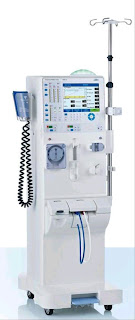Dialysis machine
A dialysis machine is a medical device that helps people with kidney failure to remove waste products and extra fluid from their blood. It does this by filtering the blood through a membrane, similar to the way healthy kidneys do.
There are two main types of dialysis machines: hemodialysis and peritoneal dialysis.
* **Hemodialysis** is the most common type of dialysis. It uses a machine to remove blood from the body, filter it through a dialyzer, and return it to the body. The dialyzer is a large filter that contains thousands of tiny pores. Waste products and extra fluid can pass through the pores, but blood cells and proteins cannot.
* **Peritoneal dialysis** uses the lining of the abdomen (peritoneum) as a filter. A special liquid called dialysate is pumped into the abdomen and allowed to sit there for a few hours. During this time, waste products and extra fluid are drawn out of the blood and into the dialysate. The dialysate is then drained out of the abdomen and replaced with fresh dialysate.
Dialysis machines are used to treat people with chronic kidney disease (CKD) who have lost the ability to function properly. CKD is a progressive disease that can eventually lead to kidney failure. Without dialysis, people with kidney failure would eventually die from the buildup of waste products and extra fluid in their bodies.
Dialysis machines are typically used three times a week for 4-5 hours each session. The length of time and frequency of dialysis treatments will vary depending on the individual's needs.
Dialysis machines are a complex piece of equipment that requires careful monitoring by a trained healthcare professional. However, they can be a life-saving treatment for people with kidney failure.
Here are some additional details about how a dialysis machine works:
* The machine has two sets of tubing: one for blood and one for dialysate.
* The blood tubing is connected to a needle in the patient's arm. The needle is inserted into a large vein, such as the subclavian vein or the femoral vein.
* The dialysate tubing is connected to a bag or canister of dialysate. The dialysate is a special liquid that contains water, salt, and other substances that are similar to the substances in blood.
* The blood and dialysate flow through the dialyzer in opposite directions. This allows the waste products and extra fluid from the blood to pass through the dialyzer's membranes into the dialysate.
* The clean blood then flows back into the patient's body through the other needle in the arm.
* The machine monitors the blood flow, pressure, and temperature during the dialysis treatment. It also monitors the levels of waste products and electrolytes in the blood.
* If any problems occur during the dialysis treatment, the machine will sound an alarm.
Dialysis machines are a vital part of the treatment for people with kidney failure. They can help to improve the quality of life for people with this condition and can even prolong their lifespan.

Comments
Post a Comment